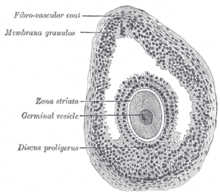Granulosa cell
Granulosa cells (from Latin granum 'grain'; "granule cells ") are cells of the epithelium in ovarian follicles . They are located in the granular cell layer ( stratum granulosum ) of a follicle and develop under the influence of gonadotropins during follicular maturation from the follicular epithelial cells of the primary follicle , which thereby becomes a secondary follicle .
Tasks in follicular maturation

In the secondary follicle, a shell of various glycoproteins , the zona pellucida or glass skin, is formed around the egg cell outside its cell membrane . A narrow perivitelline space remains between the cell membrane and the zona pellucida. The surrounding follicular epithelium then becomes multilayered and the inner layer of granulosa cells aligns itself radially, called corona radiata . Their cells reach through the envelope with cytoplasmic extensions and are in direct contact with the egg cell via gap junctions .
In the maturing tertiary follicle , the follicular cavity ( antrum folliculare ) enlarges with the fluid released by granulosa cells ( liquor follicular ). In the antral follicle, it surrounds the cumulus oophorus ("supporting hill"), which carries the egg cell within the corona radiata . A narrow cell zone ( discus proligerus ) connects it with the layer of granulosa cells which, as the granular membrane, now form the inner lining of the follicular cavity wall .

In the further course, the connective tissue surrounding the epithelial cells with the follicle cavity differentiates into two layers, called theca externa and theca interna . The theca cells of the inner vascular layer form androgenic steroid hormones and their precursors and release them; These pass through the basement membrane to neighboring granulosa cells, where, under the action of the enzyme aromatase, estrogens are formed, especially estradiol . A sharp increase in estradiol production marks the ready-to- jump Graafian follicle .
Even after the follicle rupture (ovulation), the egg cell still surrounds a layer of cumulus granulosa cells of the corona radiata adjacent to the zona pellucida , with which signals are exchanged. The entire structure outside the ovary is normally taken up by the fimbriae ("fringes") of the fallopian tube and transported through its tube ( tuba uterina ) in the direction of the uterine cavity ( cavitas uteri ).
The cells of the egg follicle that remain in the ovary after ovulation transform and store lipids ( luteinization ). The (mural) granulosa cells previously lining the follicle wall become the granulosalutein cells of the corpus luteum ( corpus luteum ); they now also produce gestagens such as progesterone .